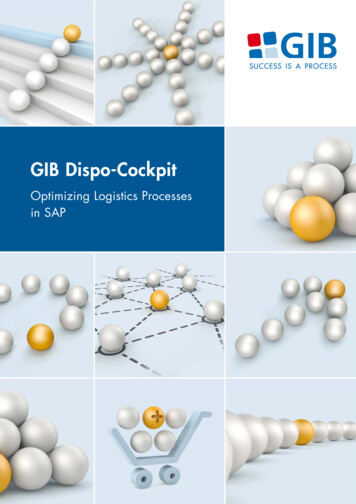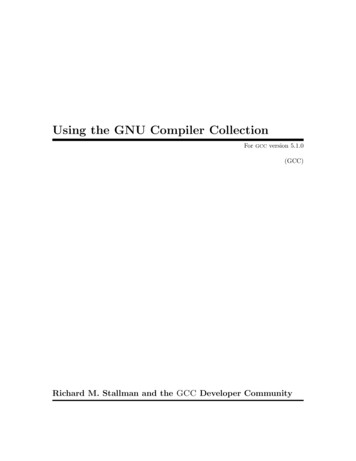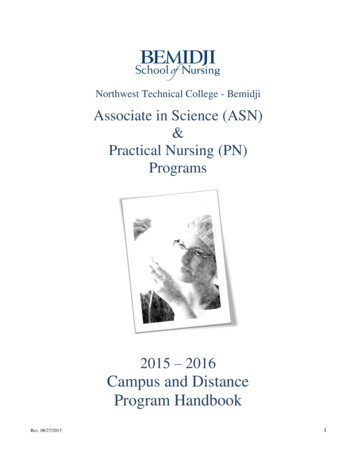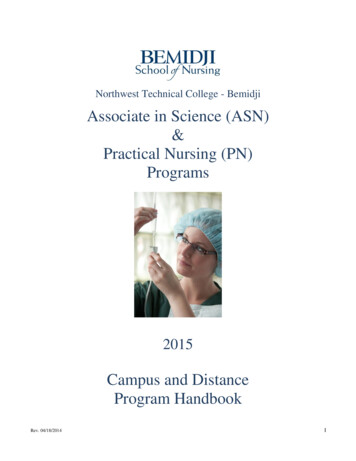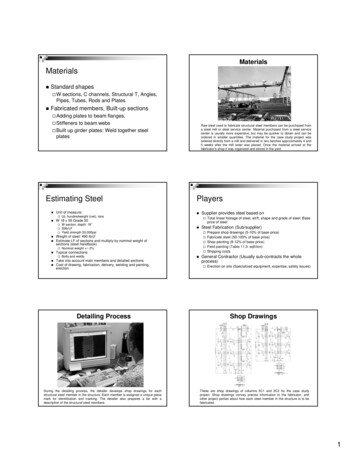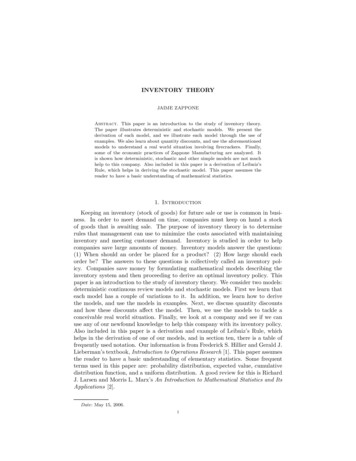
Transcription
Controlling Sequence-to-Sequence Models - A Demonstration onNeural-based Acrostic GeneratorLiang-Hsin Shen, Pei-Lun Tai, Chao-Chung Wu, Shou-De LinDepartment of Computer Science and Information Engineering,National Taiwan University{laurice, b04902105, r05922042, sdlin}@csie.ntu.edu.twAbstractof the generated content. One drawback of aneural-based Seq2Seq model is that the outputsare hard to control since the generation followscertain non-deterministic probabilistic model (orlanguage model), which makes it non-trivial toimpose a hard-constraint such as acrostic (i.e.micro-controlling the position of a specific token) and rhyme. In this work, we present anNLG system that allows the users to micro-controlthe generation of a Seq2Seq model without anypost-processing. Besides specifying the tokensand their corresponding locations for acrostic, ourmodel allows the users to choose the rhyme andlength of the generated lines. We show thatwith simple adjustment, a Seq2Seq model suchas the Transformer (Vaswani et al., 2017) canbe trained to control the generation of the text.Our demo system focuses on Chinese and Englishlyrics, which can be regarded as a writing stylein between articles and poetry. We consider ageneral version of acrostic writing, which meansthe users can arbitrarily choose the position toplace acrostic tokens. The 2-minute demonstration video can be found at https://youtu.be/9tX6ELCNMCE.An acrostic is a form of writing for whichthe first token of each line (or other recurringfeatures in the text) forms a meaningful sequence. In this paper we present a generalizedacrostic generation system that can hide certain message in a flexible pattern specified bythe users. Different from previous works thatfocus on rule-based solutions, here we adopta neural-based sequence-to-sequence model toachieve this goal. Besides acrostic, users canalso specify the rhyme and length of the outputsequences. To the best of our knowledge, thisis the first neural-based natural language generation system that demonstrates the capabilityof performing micro-level control over outputsentences.1IntroductionAcrostic is a form of writing aiming at hidingmessages in text, often used in sarcasm or to deliver private information. In previous works, English acrostic have been generated by searchingfor paraphrases in WordNet’s synsets (Stein et al.,2014). Synonyms that contain needed charactersreplace the corresponding words in the context togenerate the acrostic. Nowadays Seq2Seq models have become a popular choice for text generation, including generating text from table (Liuet al., 2018), summaries (Nallapati et al., 2016),short-text conversations (Shang et al., 2015), machine translation (Bahdanau et al., 2015; Sutskeveret al., 2014) and so on. In contrast to a rule-basedor template-based generator, such Seq2Seq solutions are often considered more general and creative, as they do not rely heavily on pre-requisiteknowledge or patterns to produce meaningful content. Although several works have presented automatic generation on rhymed text (Zhang andLapata, 2014; Ghazvininejad et al., 2016), theworks do not focus on controlling the rhyme2 Model DescriptionNormally a neural-based Seq2Seq model islearned using input/output sequences as trainingpairs (Nallapati et al., 2016; Cho et al., 2014a). Byproviding sufficient amount of such training pairs,it is expected that the model learns how to producethe output sequences based on the inputs. Here wewould like to first report a finding that a Seq2Seqmodel is capable of discovering the hidden associations between inputting control signals and outputting sequences. Based on the finding we havecreated a demo system to show that the users canindeed guide the outputs of a Seq2Seq model in a43Proceedings of the 2019 EMNLP and the 9th IJCNLP (System Demonstrations), pages 43–48Hong Kong, China, November 3 – 7, 2019. c 2019 Association for Computational Linguistics
Figure 1: The structure of Transformer model.rain 1 T elling IY N 8 S2 :Telling me just what a fool I’ve beenfine-grained manner. In our demo, the users are allowed to control three aspects of the generated sequences: rhyme, sentence length and the positionsof designated tokens. In other words, our Seq2Seqmodel not only is capable of generate next line satisfying the length and rhyme constraints providedby the user, it can also produce the exact word ata position specified by the user. The rhyme of asentence is the last syllable of the last word in thatsentence. The length of a sentence is the numberof tokens in that sentence. To elaborate how ourmodel is trained, we use three consecutive lines(denoted as S1 , S2 , S3 ) of lyrics from the song“Rhythm of the Rain” as an example. Normally aSeq2Seq model is trained based on the followinginput/output pairs.S2 :Telling me just what a fool I’ve been 2 wish 6 go EY N 12 S3 : I wishthat it would go and let me cry in vainThe three types of control signals are separatedby “ ”. The first control signal indicates the position of the designated words. 1 T elling tells thesystem the token T elling should be produced atthe first position of the output sequence s2 . Similarly, 2 wish 6 go means that the second/sixthtoken in the output sequence shall be wish/go.The second control signal is the rhyme of thetarget sentence. For instance, IHN correspondsto a specific rhyme (/In/) and EY N correspondsto another (/en/). Note that here we use the formalname of the rhyme (e.g. EY N ) to improve readability. To train our system, any arbitrary symbolwould work. The third part contains a digit (e.g.8) to control the length of the output line.By adding such additional information,Seq2Seq models can eventually learn themeaning of the control signal as they canproduce outputs according to those signals withvery high accuracy. Note that in our demo,all results are produced by our Seq2Seq modelwithout any post-processing, nor do we provideany prerequisite knowledge about what length,rhyme or position really stands for to the model.We train our system based on the Transformermodel (Vaswani et al., 2017), though additionalexperiments show that other RNN-based Seq2Seqmodels such as the one based on GRU (Cho et al.,2014b) or LSTM would also work. The modelconsists of an encoder and a decoder. Our encoderS1 :Listen to the rhythm of the fallingrain S2 : Telling me just what a foolI’ve beenS2 :Telling me just what a fool I’ve been S3 : I wish that it would go and let mecry in vainWith some experiments on training Seq2Seq models, we have discovered an interesting fact: Byappending the control signals in the end of theinput sequences, after seeing sufficient amount ofsuch data, the Seq2Seq model can automaticallydiscover the association between input signals andoutputs. Once the associations are identified, thenwe can use the control signals to guide the outputof the model. For instance, here we append additional control information to the end of the trainingsequence as belowS1 :Listen to the rhythm of the falling44
Figure 2: The structure of our acrostic generating system.consists of two identical layers when trainingon Chinese lyrics and four identical layers whentraining on English lyrics. Each layer includestwo sub-layers. The first is a multi-head attentionlayer and the second one is a fully connected feedforward layer. Residual connections (He et al.,2016) are implemented between the sub-layers.The decoder also consists of two identical layerswhen training on Chinese lyrics and four identicallayers when training on English lyrics. Each layerincludes three sub-layers: a masked multi-head attention layer, a multi-head attention layer that performs attention over the output of encoder and afully-connected feed-forward layer. The modelstructure is shown in Figure 1. Note that in theoriginal paper (Vaswani et al., 2017), Transformerconsists of six identical layers for both encoderand decoder. To save resource, we start trainingwith fewer layers than the original paper and discover that the model still performs well. Thus, weuse fewer layers than the proposed Transformermodel.3different rhymes for users to choose from.As for English lyrics, there are 30 differentrhymes for users to choose from. Theme of topic: The theme given by useris used to generate the zeroth sentence. InChinese Acrostic demonstration, our systemwould pick a sentence from training set thatis most similar to the user input, measuredby the number of n-grams. As for EnglishAcrostic demo, the user input of theme is directly used as the zeroth sentence. Length of each line: User can specify thelength of every single line (separated by ;).For example, “5;6;7” means that the userwants to generate acrostic that contains 3lines, with length equals to 5, 6, 7, respectively. The sequence of tokens to be hidden in theoutput sequences. Hidden Pattern: The exact positions for eachtoken to be hidden. Apart from the commonoptions, such as hiding in the first/last positions of each sentence or hiding in the diagonal positions, our system offers a more general and flexible way to define the pattern,realized through the Draw It M yself option. As shown in the bottom right corner ofUser InterfaceFigure 2 illustrates the interface and data flow ofour acrostic lyric generating system. First, thereare several conditions (or control signals) thatcan be specified by the users: Rhyme: For Chinese lyrics, there are 3345
Figure 2, a table based on the length of eachline specified by the users is created for theusers to select the positions to place acrostictokens.tokens, the rhyme of each line and the lengthof each line. The evaluation set consists of30,000 lines that are not included in training data.We first evaluate how accurate the control conditions can be satisfied. As shown in Table 1,the model can almost perfectly satisfy the requestfrom users. We also evaluate the quality of learnedlanguage model for Chinese/English lyrics. Thebi-gram perplexity of original training corpus is54.56/53.2. The bi-gram perplexity of generatedlyrics becomes lower (42.33/42.34), which indicates the language model does learn a better wayto represent the lyrics data. In this experimentwe find that training on English lyrics is harderthan training on Chinese lyrics. English has strictgrammatical rules while Chinese lyrics have morefreedom in forming a sentence. We also observethat the model tends to generate sentences that usethe same words that appear in their previous sentences. This behavior might be learned from therepetition of lyrics lines.The generation is done on the server side. Afterreceiving the control signals provided by users,the server first uses the given theme to searchfor a related line (denoted as zeroth sequence)from the lyric corpus, based on both sentence-levelmatching and character-level matching. Then thegiven condition of first sentence is appended tothis zeroth sequence to serve as initial input tothe Seq2Seq model for generating first line of outputs. Next, the given condition of second sentenceis appended to the generated first line as input togenerate the second line. The same process is repeated until all lines are generated.4Experiment and Results4.1 Data setWe have two versions: one training on Chineselyrics and one on English lyrics.The Chinese lyrics are crawled from Mojimlyrics site and NetEase Cloud. To avoid rare characters, the vocabulary size is set to the most frequent 50,000 characters. The English lyrics arecrawled from Lyrics Freak. The vocabulary size isset to the most frequent 50,000 words. For eachline of lyrics, we first calculate its length and thenretrieve the rhyme of the last token. To generatethe training pairs, we randomly append to the inputsequence some tokens and their positions ofthe targeting sequence as the first control signal,followed by the rhyme and then length. Beloware two example training pairs:4.3 Demonstration of ResultsWe provide our system outputs from different aspects.The first example in Figure 3 shows that wecan control the length of each line to produce atriangle-shaped lyrics.S1 : Listen to the rhythm of the f allingrain 2 me 3 just IY N 8 S2 :Telling me just what a fool I’ve beenS2 :Telling me just what a fool I’ve been 2 wish 6 go 7 and EY N 12 S3 :I wish that it would go and let me cry invainFigure 3: Length control of each sentence.Second, we would like to demonstrate the results in generating acrostic. Some people useacrostic to hide message that has no resemblancewith the content of the full text. We would showboth English and Chinese examples generated byour system.Figure 4 shows hiding a sentence in the firstIn total there are about 651,339/1,000,000 trainingpairs we use to train our Chinese/English acrosticsystems.4.2 EvaluationOur system has three controllable conditions ongenerating acrostic: the positions of designated46
ConditionCharacter (CH) / Word (EN) PositionRhymeSentence LengthSourceTraining dataModel generated 85%Perplexity(English)53.242.34Table 1: The accuracy of each condition tested on 30,000 lines and the perplexity of the original text and the textgenerated by our model.word of each sentences. The sentence that being concealed in the lyrics is I don′ t like you,which is very different from the meaning of thefull lyrics.Figure 6: Message in English lyrics: be the changeyou wish to see in the world. To make the diamondshape clearer, the words are aligned.Figure 4: Message in English lyrics: I don′ t like you.of hiding a sentence in the shape of diamond in thegenerated lyrics. The message being concealed isbe the change you wish to see in the world.Figure 7 shows that we can hide the message usingthe shape of a heart.Figure 5: Hidden message in Chinese lyrics: 甚麼都可以藏 with rhyme eng.Figure 5 shows a Chinese acrostic generated byour system. We hide a message 甚麼都可以藏(Anything can be hidden) in the diagonal line ofa piece of lyrics that talks about relationship anddream.Third, we can also play with the visual shape ofthe designated words. Figure 6 shows an exampleFigure 7: The designated characters form a heart. Thesentence hidden in the lyrics is 疏影橫斜水清淺暗香浮動月黃昏 (The shadow reflects on the water and thefragrance drifts under the moon with the color of dusk)with rhyme i.47
5ConclusionTianyu Liu, Kexiang Wang, Lei Sha, Baobao Chang,and Zhifang Sui. 2018. Table-to-text generationby structure-aware seq2seq learning. In Proceedings of the Thirty-Second AAAI Conference on Artificial Intelligence, (AAAI-18), the 30th innovativeApplications of Artificial Intelligence (IAAI-18), andthe 8th AAAI Symposium on Educational Advancesin Artificial Intelligence (EAAI-18), New Orleans,Louisiana, USA, February 2-7, 2018, pages 4881–4888.We show that by appending additional information in the training input sequences, it is possible to train a Seq2Seq model whose outputs canbe controlled in a fine-grained level. This finding enables us to design and demonstrate a general acrostic generating system with various features controlled, including the length of each line,the rhyme of each line and the target tokens to beproduced and their corresponding positions. Ourresults have shown that the proposed model notonly is capable of generating meaningful content,it also follows the constraints with very high accuracy. We believe that this finding can furtherlead to other useful applications in natural language generation.Ramesh Nallapati, Bowen Zhou, Cícero Nogueira dosSantos, Çaglar Gülçehre, and Bing Xiang. 2016.Abstractive text summarization using sequence-tosequence rnns and beyond. In Proceedings of the20th SIGNLL Conference on Computational NaturalLanguage Learning, CoNLL 2016, Berlin, Germany,August 11-12, 2016, pages 280–290.Lifeng Shang, Zhengdong Lu, and Hang Li. 2015.Neural responding machine for short-text conversation. In Proceedings of the 53rd Annual Meeting of the Association for Computational Linguisticsand the 7th International Joint Conference on Natural Language Processing of the Asian Federation ofNatural Language Processing, ACL 2015, July 2631, 2015, Beijing, China, Volume 1: Long Papers,pages 1577–1586.ReferencesDzmitry Bahdanau, Kyunghyun Cho, and Yoshua Bengio. 2015. Neural machine translation by jointlyIn 3rd Interlearning to align and translate.national Conference on Learning Representations,ICLR 2015, San Diego, CA, USA, May 7-9, 2015,Conference Track Proceedings.Benno Stein, Matthias Hagen, and Christof Bräutigam.2014. Generating acrostics via paraphrasing andheuristic search. In COLING 2014, 25th International Conference on Computational Linguistics,Proceedings of the Conference: Technical Papers,August 23-29, 2014, Dublin, Ireland, pages 2018–2029.Kyunghyun Cho, Bart van Merrienboer, ÇaglarGülçehre, Dzmitry Bahdanau, Fethi Bougares, Holger Schwenk, and Yoshua Bengio. 2014a. Learningphrase representations using RNN encoder-decoderfor statistical machine translation. In Proceedings ofthe 2014 Conference on Empirical Methods in Natural Language Processing, EMNLP 2014, October25-29, 2014, Doha, Qatar, A meeting of SIGDAT,a Special Interest Group of the ACL, pages 1724–1734.Ilya Sutskever, Oriol Vinyals, and Quoc V. Le. 2014.Sequence to sequence learning with neural networks. In Advances in Neural Information Processing Systems 27: Annual Conference on Neural Information Processing Systems 2014, December 813 2014, Montreal, Quebec, Canada, pages 3104–3112.Kyunghyun Cho, Bart van Merriënboer, ÇalarGülçehre, Dzmitry Bahdanau, Fethi Bougares, Holger Schwenk, and Yoshua Bengio. 2014b. Learningphrase representations using rnn encoder–decoderfor statistical machine translation. In Proceedings ofthe 2014 Conference on Empirical Methods in Natural Language Processing (EMNLP), pages 1724–1734, Doha, Qatar. Association for ComputationalLinguistics.Ashish Vaswani, Noam Shazeer, Niki Parmar, JakobUszkoreit, Llion Jones, Aidan N. Gomez, LukaszKaiser, and Illia Polosukhin. 2017. Attention is allyou need. In Advances in Neural Information Processing Systems 30: Annual Conference on NeuralInformation Processing Systems 2017, 4-9 December 2017, Long Beach, CA, USA, pages 6000–6010.Xingxing Zhang and Mirella Lapata. 2014. Chinesepoetry generation with recurrent neural networks. InProceedings of the 2014 Conference on EmpiricalMethods in Natural Language Processing, EMNLP2014, October 25-29, 2014, Doha, Qatar, A meeting of SIGDAT, a Special Interest Group of the ACL,pages 670–680.Marjan Ghazvininejad, Xing Shi, Yejin Choi, andKevin Knight. 2016. Generating topical poetry. InProceedings of the 2016 Conference on EmpiricalMethods in Natural Language Processing, EMNLP2016, Austin, Texas, USA, November 1-4, 2016,pages 1183–1191.Kaiming He, Xiangyu Zhang, Shaoqing Ren, and JianSun. 2016. Deep residual learning for image recognition. In 2016 IEEE Conference on Computer Vision and Pattern Recognition, CVPR 2016, Las Vegas, NV, USA, June 27-30, 2016, pages 770–778.48
lyrics, which can be regarded as a writing style in between articles and poetry. We consider a general version of acrostic writing, which means the users can arbitrarily choose the position to place acrostic tokens. The 2-minute demonstra-tion video can be found at https://youtu. be/9tX6ELCNMCE. 2 Model Description Normally a neural-based .
